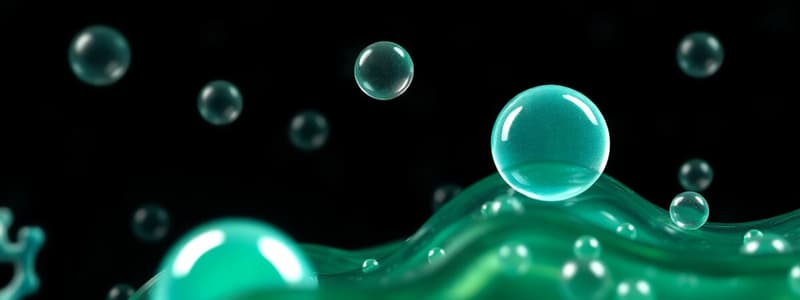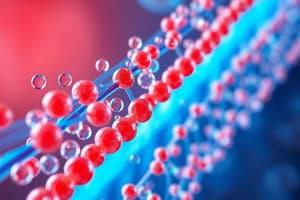Podcast
Questions and Answers
Which characteristic is NOT associated with peripheral membrane proteins?
Which characteristic is NOT associated with peripheral membrane proteins?
- Strongly bound to the membrane (correct)
- Dissociated with mild detergents
- Dissociated with high salt concentrations
- Associated with the membrane surface
Lipid bilayers are primarily held together by covalent bonds between the lipid molecules.
Lipid bilayers are primarily held together by covalent bonds between the lipid molecules.
False (B)
What is the primary difference between flippases and floppases in terms of lipid movement across a membrane?
What is the primary difference between flippases and floppases in terms of lipid movement across a membrane?
Flippases move lipids from the outer to the inner leaflet, while floppases move lipids from the inner to the outer leaflet of the membrane.
In lipid-anchored proteins, __________ is a type of anchor linked by an amide bond to the amino group of N-terminal Gly.
In lipid-anchored proteins, __________ is a type of anchor linked by an amide bond to the amino group of N-terminal Gly.
Match each type of integral membrane protein with its structural characteristic:
Match each type of integral membrane protein with its structural characteristic:
Which factor primarily governs the self-association of lipids to form membranes?
Which factor primarily governs the self-association of lipids to form membranes?
The transition temperature for membrane fluidity is solely determined by the length of the fatty acid chains in the membrane lipids.
The transition temperature for membrane fluidity is solely determined by the length of the fatty acid chains in the membrane lipids.
How does cholesterol affect membrane fluidity at different temperatures?
How does cholesterol affect membrane fluidity at different temperatures?
A hydropathy plot is used to identify membrane protein topology and is based on the _________ of amino acids.
A hydropathy plot is used to identify membrane protein topology and is based on the _________ of amino acids.
Match each type of membrane protein with its definition:
Match each type of membrane protein with its definition:
Which of the following is least likely to cross a lipid bilayer by simple diffusion?
Which of the following is least likely to cross a lipid bilayer by simple diffusion?
Scramblases require ATP to move lipids across the cell membrane.
Scramblases require ATP to move lipids across the cell membrane.
Differentiate between primary and secondary active transport.
Differentiate between primary and secondary active transport.
In the gel phase of a lipid bilayer, lipid chains are __________ and packed closely together.
In the gel phase of a lipid bilayer, lipid chains are __________ and packed closely together.
Match each type of cotransport with its definition:
Match each type of cotransport with its definition:
Which of the following integral membrane protein types contains amino acid loops?
Which of the following integral membrane protein types contains amino acid loops?
Lateral movement of lipids in a membrane is generally slower than transverse movement.
Lateral movement of lipids in a membrane is generally slower than transverse movement.
What structural characteristic distinguishes a micelle from a liposome?
What structural characteristic distinguishes a micelle from a liposome?
A(n) __________ is formed at an air/water interface, consisting of a single-molecule thick layer with polar groups interacting with water.
A(n) __________ is formed at an air/water interface, consisting of a single-molecule thick layer with polar groups interacting with water.
Match the following terms with their descriptions related to membrane protein interactions:
Match the following terms with their descriptions related to membrane protein interactions:
Flashcards
What are amphipathic lipids?
What are amphipathic lipids?
Molecules with both polar and nonpolar regions, arranged in bilayers in cell membranes.
What is a monolayer?
What is a monolayer?
A single-molecule thick layer at the air/water interface, with polar groups interacting with water.
What are Micelles?
What are Micelles?
Lipid spheres with polar groups facing outward and hydrophobic tails clustered in the center.
What is a lipid bilayer?
What is a lipid bilayer?
Signup and view all the flashcards
What are Liposomes?
What are Liposomes?
Signup and view all the flashcards
What are Peripheral membrane proteins?
What are Peripheral membrane proteins?
Signup and view all the flashcards
What are Integral membrane proteins?
What are Integral membrane proteins?
Signup and view all the flashcards
What are Lipid-anchored proteins?
What are Lipid-anchored proteins?
Signup and view all the flashcards
Is the cell membrane polar or nonpolar?
Is the cell membrane polar or nonpolar?
Signup and view all the flashcards
What is a Hydropathy plot?
What is a Hydropathy plot?
Signup and view all the flashcards
What is Lateral membrane mobility?
What is Lateral membrane mobility?
Signup and view all the flashcards
What is Transverse membrane mobility?
What is Transverse membrane mobility?
Signup and view all the flashcards
What are Flippases?
What are Flippases?
Signup and view all the flashcards
What are Floppases?
What are Floppases?
Signup and view all the flashcards
What are Scramblases?
What are Scramblases?
Signup and view all the flashcards
What is Gel phase?
What is Gel phase?
Signup and view all the flashcards
What is Liquid crystalline phase?
What is Liquid crystalline phase?
Signup and view all the flashcards
What is Melting temperature (Tm)?
What is Melting temperature (Tm)?
Signup and view all the flashcards
What is Passive diffusion?
What is Passive diffusion?
Signup and view all the flashcards
What is Facilitated diffusion?
What is Facilitated diffusion?
Signup and view all the flashcards
Study Notes
Membrane Composition
- Lipids are amphiphatic molecules arranged as bilayers with polar groups facing out and nonpolar groups facing in.
- Proteins are surface-associated or embedded in the bilayer.
- Lipids self-associate to form membranes due to the hydrophobic effect.
- Monolayers are single-molecule thick layers at the air/water interface, featuring polar groups interacting with water.
- Micelles are lipid spheres with polar groups oriented outwards and hydrophobic tails positioned centrally.
- Lipid bilayers consist of two lipid monolayers with hydrophobic surfaces facing each other.
- Liposomes are vesicles formed by lipid bilayers.
- The phospholipid bilayer is a flexible, sheet-like structure, described by the fluid mosaic model.
Types of Membrane Proteins
- Peripheral membrane proteins are not strongly bound to the membrane and can be dissociated using mild detergents or high salt concentrations.
- Integral membrane proteins are strongly embedded in the membrane and can be dissociated with strong detergents that denature the membrane.
- Lipid-anchored proteins are covalently attached to a lipid embedded in the membrane.
Types of Integral Membrane Proteins
- TYPE 1 has a C-terminal IN and an N-terminal OUT, featuring an alpha-helix structure.
- TYPE 2 exhibits a C-terminal OUT and an N-terminal IN.
- TYPE 3 contains amino acid loops.
- TYPE 4 consists of separate polypeptide chains.
- TYPE 5 involves a short chain lipid.
- TYPE 6 involves a long chain lipid.
Types of Lipid-Anchored Proteins
- Amide-linked myristoyl anchors use myristic acid (14:0) as the anchor.
- These are linked by an amide to the amino group of N-terminal Gly.
- Thioester-linked fatty acyl anchors use fatty acid as the anchor.
- Prenyl anchors use prenyl (long-chain isoprene polymers) as the anchor.
- Farnesyl is utilized as an anchor.
- Anchors are attached to Cys as a thioester or Ser or Thr as an ester.
- Anchors can be attached as a thioester to Ct Cys.
Glycosyl Phosphatidylinositol
- Glycosyl phosphatidylinositol is an oligosaccharide-modified phosphoinositol used as an anchor.
- Ct is attached via phosphoethanolamine to the Man residue of oligosaccharide.
- The cell membrane is nonpolar.
- The hydropathy plot (Kyte-Doolittle) uses the hydropathy index of amino acids to identify membrane protein topology.
- An increasing number of hydropathy indices means decreasing polarity (or increasing nonpolarity).
Membrane Mobility
- There are two types of membrane mobility: Lateral and Transverse.
- Lateral mobility involves side-to-side movement and is fast.
- Transverse movement goes from the inner to the outer layer (or reverse) and is slow.
- Transverse movement is slower than lateral because the polar head group of lipids must pass through the hydrophobic core of the lipid bilayer.
- This is unfavorable because the hydrophobic interior resists the passage of water-soluble molecules.
Enzymes Assisting in Transverse Movement
- Flippases are ATP-dependent and use energy to move phosphotidyl Serine from the OUTER to INNER surface of the membrane.
- Floppases are ATP-dependent and use energy to move lipids from the INNER to the OUTER surface of the membrane.
- Floppases usually transport cholesterol, phosphotidylcholine, and sphingomyelin.
- Scramblases/Flipfloppases are Ca2+-dependent and ATP-independent, thus not requiring energy.
- They move lipids in either direction, working towards equilibrium.
Membrane Phases and Fluidity
- The Gel Phase (Solid-Ordered State) sees individual molecules unable to move around.
- Lipid chains are extended and closely packed in the gel phase.
- The Liquid Crystalline Phase (Liquid-Disordered State) enables molecules to move around.
- Acyl bonds rotate and bend, membrane thickness decreases, and surface area increases in this phase.
- Membrane fluidity can be varied with temperature.
-
- i. Melting temperature denotes the point at which a phase transition takes place.
-
- ii. An increase in temperature advances the substance from a gel to a liquid phase.
-
- Membrane fluidity can also be varied with cholesterol.
-
- i. Cholesterol broadens the transition range without altering the melting temperature
-
- ii. At low temperatures, it helps membranes become more rigid.
-
- Membrane fluidity can also be varied by type of fatty acid.
-
- i. Longer fatty acids favor rigidity and increase melting temperature.
-
- ii. Saturated fatty acids favor rigidity and increase melting temperature.
-
Types of Membrane Transport
- Passive diffusion is entropy-driven, moves along the gradient (high to low concentration), and is concentration-dependent.
- Does not involve channels/transporters.
- Only small, nonpolar molecules are needed in order to pass across the nonpolar membrane.
- Facilitated diffusion is entropy-driven and moves along the gradient (high to low concentration).
- It is concentration-dependent, saturable, and specific/selective.
- It involves membrane channels, commonly integral membrane proteins.
- Active Transport is energy-driven, moves AGAINST the gradient, and is specific.
- Involves transporters, commonly integral membrane proteins.
Types of Passive Diffusion
- Concentration gradient involves differences in concentration between regions.
- It is a spontaneous process that does not require energy, and energy is released in the process.
- Electrical gradient involves differences in charges between regions.
- It is also known as electrical potential difference.
- Electrochemical gradient involves differences in concentration and charges.
Facilitated Diffusion
- Channels are transmembrane proteins (integral membrane proteins) that react to chemicals and physical changes in the environment.
- Voltage-gated channels are activated in response to a change in membrane voltage.
- Ligand-gated channels are activated in response to a ligand.
Types of Active Transport
- Primary transport uses ATP, light, or redox chains as a source of energy.
- It involves pumps, and moves AGAINST the gradient.
- Secondary transport uses an ion gradient (driven by ions moving along their gradient).
- It is also called cotransport.
Types of Cotransport
- Symporters transport a molecule against its gradient along with another molecule moving along its gradient in the same direction.
- Antiporters transport a molecule against its gradient along with another molecule moving along its gradient in the opposite direction.
Studying That Suits You
Use AI to generate personalized quizzes and flashcards to suit your learning preferences.



